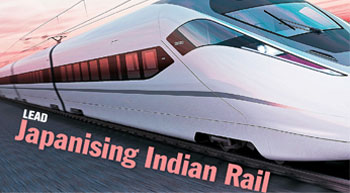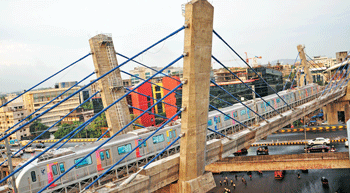The Central government approved Smart Cities Mission involves the development of one hundred smart cities in India. One of the most important elements of smart city infrastructure is economical and environment friendly mass scale rapid public transport system.
FlashNews:
South Asia Must Scale Hydro, Storage and Power Trading for Grid Integration: CEA Chief
India Can Save $204 Billion in Infra Pipeline with Better DPR Planning: Vector Consulting
Prime Minister Modi Inaugurates Skyroot’s Rocket Factory; Company Targets $21 Billion Launch Market
IWAI Signs ₹13.5 Billion MoUs to Boost Ganga Waterway in Uttar Pradesh
MOVIN Launches Healthcare Logistics Vertical to Tap India’s $638 Billion Industry
Atlanta Electricals Secures ₹2.98 Billion Transformer Orders from GETCO
Waaree Group Wins 10 MWh BESS Order in Tamil Nadu, Expands Domestic Storage Manufacturing
Cabinet Approves ₹27.8 Billion Rail Multitracking to Boost Gujarat and Maharashtra Connectivity
BC Jindal Group Secures 150 MW RTC Power Deal with SECI
India’s Data Centre Revenue to Hit ₹200 Billion By FY2028, Driven by AI, Cloud and 5G: Crisil Ratings
Sanchar Saathi Recovers 50,000 Phones in October; Crosses 700,000 Nationwide Since Launch
Akasa Air Expands Northeast Connectivity, Adds Dibrugarh as 32nd Destination
Ministry of Power Advances India Energy Stack with Taskforce Review of Strategy and Architecture
Vaishnaw Stresses Industry-Aligned Skilling to Power India’s Digital and Electronics Growth
DGCA Issues Urgent Advisory as Ethiopian Ash Cloud Enters Indian Airspace
DFCCIL Freight Operations Surge 48% as Corridors, Terminals Expand
SMFCL Board Clears $3 Billion Borrowing Plan to Accelerate Maritime Infrastructure Financing
Air India Restores Codeshare with Air Canada to Expand India-Canada Flight Network
Indian Railways Freight Loading Surges Past 1 Billion Tonne Milestone This Fiscal
Tag: Biswanath Bhattacharya
Rationale behind HSR
An investment in HSR is typically a government decision which is primarily dependent on a number of factors, such as current and projected traffic, expected saving in time, and a reduction in accidents due to a modal shift, reduction in environmental externalities, ease in congestion in existing modes, and the average willingness of the users to pay.
Japanising Indian Rail
Taking precedence from Japan which heralded the ´bullet train´ legacy in 1964, the world began to partake of this ´race against time´. High-speed rail (HSR), which uses an integrated system of specialised rolling stock and dedicated tracks, can significantly enhance the connectivity and trade between major cities in a country.
Funding Dichotomy
The population surge, rapid urbanisation, and the consequent congestion have time and again fuelled the ´need for speed´. Mass rapid transit system like the metro rail has dawned as a panacea in this regard.




